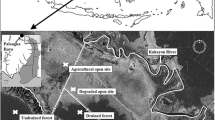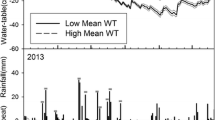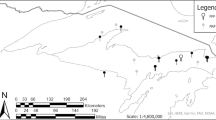Abstract
Background and Aims
Tropical peat swamp forests (PSF) are great stores of terrestrial carbon and host unique biodiversity. Despite their importance for carbon accounting, the peat characteristics are sparsely studied, and the effect of microtopography on peat properties has not been reported before.
Methods
We compared PSF peat soil characteristics down to 70 cm under differing microtopographical conditions and hydrology.
Results
Long-term water table level data combined with the data from peat structure and chemistry analyses showed differences in most of the measured properties between hummocks and hollows. Decomposition degree was lowest at hummock and hollow surfaces while bulk density and C content increased towards deeper peat. Ash, P, K, Ca and Mg had highest concentrations on hummock surfaces with declining trend downwards, whereas N had no clear concentration pattern along the elevation gradient.
Conclusions
The microtopographical features may not only differ in regards to the water table-induced oxygen conditions but also due to differences in nutrient dynamics.








Similar content being viewed by others
Abbreviations
- PSF:
-
Peat swamp forest
- C/N ratio:
-
Carbon nitrogen ratio
References
Anderson J (1983) The tropical peat swamps of western Malesia. In: Gore A (ed) Mires: swamp, bog, fen and moor. B. Regional studies Elsevier, Amsterdam, pp 181–199
Anshari GZ, Afifudin M, Nuriman M, Gusmayanti E, Arianie L, Susana R, Nusantara RW, Sugardjito J, Rafiastanto A (2010) Drainage and land use impacts on changes in selected peat properties and peat degradation in West Kalimantan Province, Indonesia. Biogeosciences 7:3403–3419
Bergner K, Bohlin E, Albano Å (1990) Vad innehåller torv? Centrum för Torvforskning Umeå, Sweden, 30 p
Brady M (1997) Effects of vegetation changes onorganic matter dynamics in three coastal peat deposits in Sumatra, Indonesia. In: Rieley JO, Page SE (eds.). Biodiversity and sustainability of tropical peatlands. Samara Publishing, Cardigan, UK. pp. 113–134
Dinsmore KJ, Skiba UM, Billett MF, Rees RM (2009) Effect of water table on greenhouse gas emissions from peatland mesocosms. Plant Soil 318:229–242
Dommain R, Couwenberg J, Joosten H (2010) Hydrological self-regulation of domed peatlands in south-east Asia and consequences for conservation and restoration. Mires and Peat 6:1–17
Finér L, Laine J (1998) Root dynamics at drained peatland sites of different fertility in southern Finland. Plant Soil 201:27–36
Hergoualc'h K, Verchot LV (2011) Stocks and fluxes of carbon associated with land use change in Southeast Asian tropical peatlands: A review. Global Biogeochem Cycles 25, GB2001
Hirano T, Jauhiainen J, Inoue T, Takahashi H (2009) Controls on the carbon balance of tropical peatlands. Ecosystems 12:873–887
Hooijer A, Page S, Jauhiainen J, Lee WA, Lu XX, Idris A, Anshari G (2012) Subsidence and carbon loss in drained tropical peatlands. Biogeosciences 9:1053–1071
Jaenicke J, Rieley JO, Mott C, Kimman P, Siegert F (2008) Determination of the amount of carbon stored in Indonesian peatlands. Geoderma 147:151–158
Jaya A (2007) Ecological planning of tropical peatland for carbon and water conservation. PhD thesis, University of Nottingham. 178 p
Kool DM, Buurman P, Hoekman DH (2006) Oxidation and compaction of a collapsed peat dome in Central Kalimantan. Geoderma 137:217–225
Kronseder K, Ballhorn U, Boehm V, Siegert F (2012) Above ground biomass estimation across forest types at different degradation levels in Central Kalimantan using LiDAR data. International Journal of Applied Earth Observation and Geoinformation 18:37–48
Kurnain A, Notohadikusumo T, Radjagukguk B, Hastuti S (2002) The state of decomposition of tropical peat soil under cultivated and fire damaged peatland. In: Rieley JO, Page SE, Setiadi B (eds.) Peatlands for People, Natural Resources Function and Sustainable Management. Proceedings of the International Symposium on Tropical Peatland, 22–23 August 2001, Jakarta. Indonesia. BPPT and Indonesian Peat Association, Jakarta, pp 168–178
Kurnain A, Notohadikusumo T, Radjagukguk B, Hastuti S (2001) Peat soil properties related to degree of decomposition under different land use systems. International Peat Journal 11:67–77
Langner A, Siegert F (2009) Spatiotemporal fire occurrence in Borneo over a period of 10 years. Global Change Biol 15:48–62
MacKinnon K, Hatta G, Halim H, Mangalik A (1996) The Ecology of Kalimantan, Indonesian Borneo. The Ecology of Indonesia Series, Volume III. Periplus Editions, Singapore. 802 p
Melling L, Uyo L, Hatano R, Osaki M (2006) Soils of Loagan Bunut National Park, Sarawak, Malaysia. Final Report. Peat Swamp Forests Project, UNDP/GEF. MAL/99/G31
Miettinen J, Liew SC (2010) Status of Peatland Degradation and Development in Sumatra and Kalimantan. Ambio 39:394–401
Morley R (2000) Origin and Evolution of Tropical Rain Forests. Wiley, UK, 362 p
Neuzil S (1997) Onset and Rate of Peat and Carbon Accumulation in Four Domed Ombrogenous Peat Deposits, Indonesia. In: Rieley JO, Page SE (eds.). Biodiversity and sustainability of tropical peatlands. Samara Publishing, Cardigan, UK. pp. 55–72
Nungesser MK (2003) Modelling microtopography in boreal peatlands: hummocks and hollows. Ecol Model 165:175–207
Ohlson M (1999) Differentiation in adaptive traits between neighbouring bog and mineral soil populations of Scots pine Pinus sylvestris. Ecography 22:178–182
Page S, Rieley J, Shotyk O, Weiss D (1999) Interdependence of peat and vegetation in a tropical peat swamp forest. Philosophical Transactions of the Royal Society of London Series B-Biological Sciences 354:1885–1897
Page SE, Rieley JO, Banks CJ (2011) Global and regional importance of the tropical peatland carbon pool. Global Change Biol 17:798–818
Page SE, Wüst R, Weiss D, Rieley JO, Shotyk W, Limin S (2004) A record of Late Pleistocene and Holocene carbon accumulation and climate change from an equatorial peat bog (Kalimantan, Indonesia): implications for past, present and future carbon dynamics. J Quat Sci 19(7):625–635
Pitkänen A, Turunen J, Simola H (2011) Comparison of different types of peat corers in volumetric sampling. Suo 62(2): 51–57
Rydin H, Jeglum J (2006) The Biology of Peatlands. Oxford University Press, UK, 343 p
Sajarwan A, Notohadiprawiro T, Radjagukguk B, Hastuti S (2002) Diversity of tropical peat characteristics in intact peatland forest, under the influence of forest type, peat thickness, and the position of the peat deposit. In: Rieley JO, Page SE, Setiadi B (eds.). Peatlands for People, Natural Resources Function and Sustainable Management. Proceedings of the International Symposium on Tropical Peatland, 22–23 August 2001, Jakarta. Indonesia. BPPT and Indonesian Peat Association, Jakarta, pp 119–124
Shepherd P, Rieley JO, Page SE (1997) The Relationship Between Forest Vegetation and Peat Characteristics in the Upper Catchment of Sungai Sabangau, Central Kalimantan. In: Rieley JO, Page SE (eds.). Biodiversity and sustainability of tropical peatlands. Samara Publishing, Cardigan, UK. pp. 191–210
Shimada S, Takahashi H, Haraguchi A, Kaneko M (2001) The carbon content characteristics of tropical peats in central Kalimantan, Indonesia; estimating their spatial variability in density. Biogeochemistry (Dordrecht) 53:249–267
Shimamura T, Momose K (2005) Organic matter dynamics control plant species coexistence in a tropical peat swamp forest. Proceedings Biological sciences/The Royal Society 272:1503–1510
Shimamura T, Momose K, Kobayashi S (2006) A comparison of sites suitable for the seedling establishment of two co-occurring species, Swintonia glauca and Stemonurus scorpioides, in a tropical peat swamp forest. Ecol Res 21:759–767
Soil Survey Staff (1999) Soil Taxonomy - a basic system of soil classification for making and interpreting soil surveys. United States Agricultural Department, Natural Resources Conservation Service Agriculture Handbook No. 436. Government Printing Office, Washington USA. 871 p
Stoneman R (1997) Ecolological Studies in the Badas Peat Swamp, Brunei Darussalam. In: Rieley JO, Page SE (eds) Biodiversity and sustainability of tropical peatlands. Samara Publishing Cardigan, UK, pp 221–230
Sulistiyanto Y (2004) Nutrient dynamics in different sub-types of peat swamp forest in central Kalimantan, Indonesia. PhD thesis, University of Nottingham, UK. 388 p
Takahashi H, Shimada S, Ibie B, Usup A, Yudha LS (2002) Annual changes of water balance and a drought index in a tropical peat swamp forest of Central Kalimantan, Indonesia. In: Rieley JO, Page SE, Setiadi B (eds.) Peatlands for People, Natural Resources Function and Sustainable Management. Proceedings of the International Symposium on Tropical Peatland, 22–23 August 2001, Jakarta. Indonesia. BPPT and Indonesian Peat Association, Jakarta, pp 63–67
Takakai F, Morishita T, Hashidoko Y, Darung U, Kuramochi K, Dohong S, Limin SH, Hatano R (2006) Effects of agricultural land-use change and forest fire on N2O emission from tropical peatlands, Central Kalimantan, Indonesia. Soil Sci Plant Nutr 52:662–674
Tolonen K, Ijäs L (1982) Comparison of two peat samplers used in estimating the dry peat yield in field inventories. Suo 33:33–42
von Post L (1922) Sveriges Geologiska Undersöknings torvinventering och några av dess hittills vunna resultat. Svenska Mosskulturföreningens Tidsskrift 1:1–27
Wahid O, Paramananthan S, Mohd H, Nordiana A, Kushairi A (2013) Malaysian unified peat classification technique. Malaysian Palm Oil Board, MPOB Information Series, 529
Waldes N, Page SE (2002) Forest structure and tree diversity of a peat swamp forest in Central Kalimantan, Indonesia. In: Rieley JO, Page SE, Setiadi B (eds.) Peatlands for People, Natural Resources Function and Sustainable Management. Proceedings of the International Symposium on Tropical Peatland, 22–23 August 2001, Jakarta. Indonesia. BPPT and Indonesian Peat Association, Jakarta, pp 16–22
Warren MW, Kauffman JB, Murdiyarso D, Anshari G, Hergoualc'h K, Kurnianto S, Purbopuspito J, Gusmayanti E, Afifudin M, Rahajoe J, Alhamd L, Limin S, Iswandi A (2012) A cost-efficient method to assess carbon stocks in tropical peat soil. Biogeosciences 9:4477–4485
Weiss D, Shotyk W, Rieley J, Page S, Gloor M, Reese S, Martinez-Cortizas A (2002) The geochemistry of major and selected trace elements in a forested peat bog, Kalimantan, SE Asia, and its implications for past atmospheric dust deposition. Geochim Cosmochim Acta 66:2307–2323
Wu J, Roulet NT, Moore TR, Lafleur P, Humphreys E (2011) Dealing with microtopography of an ombrotrophic bog for simulating ecosystem-level CO2 exchanges. Ecol Model 222:1038–1047
Wüst RAJ, Bustin RM, Lavkulich LM (2003) New classification systems for tropical organic-rich deposits based on studies of the Tasek Bera Basin, Malaysia. Catena 53:133–163
Yonebayashi K, Okazaki M, Kaneko N, Funakawa S (1997) Tropical Peatland Soil Ecosystems in Southeast Asia: Their Characterisation and Sustainable Utilisation. In: Rieley JO, Page SE (eds) Biodiversity and sustainability of tropical peatlands. Samara Publishing, Cardigan, UK, pp 103–111
Acknowledgments
We would like to thank Dr. Hidenori Takahashi for kindly providing us the water level data. We would also like to thank Iida Kämäri, CIMTROP staff and our funding body the Academy of Finland by KEYTROP and RETROPEAT (no. 253933) projects. Three reviewers and the subject editor are acknowledged for their thorough and constructive remarks on the manuscript.
Author information
Authors and Affiliations
Corresponding author
Additional information
Responsible Editor: Tim Moore.
Electronic supplementary material
Below is the link to the electronic supplementary material.
ESM 1
(DOCX 21 kb)
Rights and permissions
About this article
Cite this article
Lampela, M., Jauhiainen, J. & Vasander, H. Surface peat structure and chemistry in a tropical peat swamp forest. Plant Soil 382, 329–347 (2014). https://doi.org/10.1007/s11104-014-2187-5
Received:
Accepted:
Published:
Issue Date:
DOI: https://doi.org/10.1007/s11104-014-2187-5




